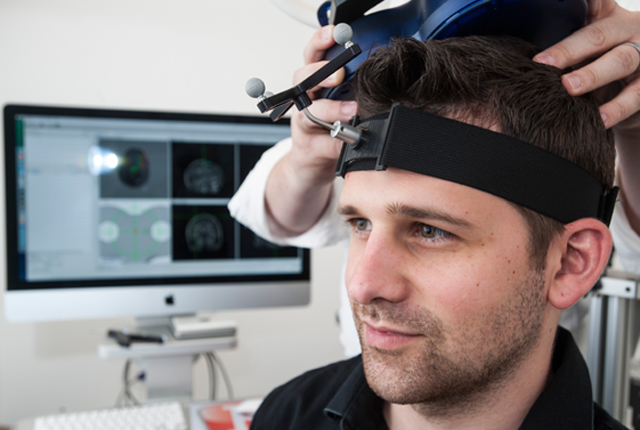With the opening of the T.L.L. Temple Foundation Neuroplasticity Research Laboratory, Rice is now home to one of the few labs in the country dedicated to helping researchers understand the behavioral consequences of stroke, epilepsy, traumatic brain injury and other neurological disorders. The 6,000-square-foot lab is housed on the seventh floor of Rice’s BioScience Research Collaborative. Randi Martin, the Elma Schneider Professor of Psychology, and Simon Fischer-Baum, assistant professor of psychology, lead the laboratory’s research team.
“The difference between the new laboratory and other cognitive neuroscience laboratories around the country is the emphasis on plasticity,” Martin said in a news release announcing the creation of the lab. “We want to know what happens to the brain during recovery and what happens between the acute stage and six months or a year down the road.”
The lab is outfitted with a variety of equipment to accomplish this.
Transcranial magnetic stimulation (TMS) is a safe and noninvasive method to stimulate brain tissue. By introducing a very brief but strong magnetic field to the scalp, TMS stimulates a small area of the brain – about a cubic centimeter – either temporarily activating that tissue or deactivating it, creating a virtual brain lesion. The system shown above allows researchers to use a participant’s brain scan to target specific regions. With this technique, they can investigate the role of a specific area of the brain in different mental processes. TMS has also been shown to improve treatment outcomes for people with neurological disorders.
Electroencephalography (EEG) techniques, including event-related potentials (ERP), provide an indirect measure of neural activity, millisecond by millisecond. When large systems of neurons fire in the brain, small amounts of electrical activity can be detected on the scalp and recorded with an electrode cap, such as the one shown above. The technique provides a window into the neural response to a range of stimuli. Data from EEG/ERP studies are critical to developing theories of the time course of mental processes involved in many human abilities, including vision, memory and language.
The EyeLink 1000 eye tracker provides rapid, highly accurate measurements of the position of a subject’s eye gaze on a display. Individuals tend to look at what they are thinking about (even though they may be unaware of it), so researchers can use the technique to determine the mental processes going on when a person understands a word or sentence by recording eye gaze on objects related to the words in the sentence. Additionally, researchers can track readers’ eyes as they move across a written text, which helps determine the features of words that speed readers up or slow them down, allowing a window into the mental processes involved in comprehension.
From left: Simon Fischer-Baum, Randi Martin.






Leave a Reply